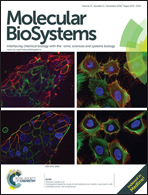Modeling the permeability of drug-like molecules through the cell wall of Mycobacterium tuberculosis: an analogue based approach†
Abstract
The emergence of drug resistant strains of Mycobacterium Tuberculosis (Mtb) accentuates the urgent need for the development of novel antitubercular drugs. The major causes of drug resistance are genetic mutations, the influx–efflux transporter system, and the complex cell wall system of Mtb, which can function as permeability barriers. The driving force for permeability of small molecules through a biological system depends on various physicochemical factors. To understand the permeability of small molecules and subsequent cell inhibition, we have developed predictive QSAR models based on reported enzyme-based (IC50) and cell-based (MIC) Mtb inhibitory data. The compounds that are highly active in enzyme-based assays and have significant variation in cell-based assays are assumed to possess the required permeability through the Mtb cell wall. The obtained models suggest the importance of molecular connectivity, lipophilicity (log P, size, shape), electrotopology (relative atomic mass, polarizability, electronegativity, ionization potential, atomic charges, van der Waals volume, hybridization, hydrogen bond acceptors/donors, number of fused rings) and functional groups (hydroxyl groups, primary and secondary amines) of a molecule in determining both its inhibitory potency and Mtb cell permeability. The models were validated with known Mtb inhibitors (9804) collected from the ChEMBL database, Mtb drugs (27) and clinical candidates (5). Further, these validated models were used to screen and prioritize a large database of compounds, including Zinc (152 128), Asinex (435 215), DrugBank (6531) and antimicrobial compounds (1324). The results obtained from 2D-QSAR analysis could improve our understanding towards Mtb cell permeability, which may aid in the rational design of novel potent molecules for tuberculosis (TB).


 Please wait while we load your content...
Please wait while we load your content...